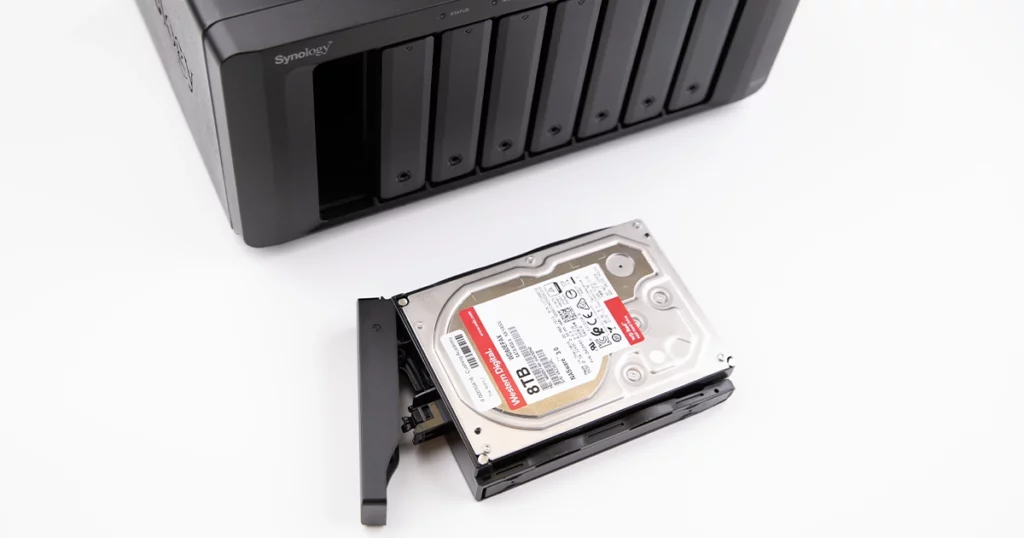When a server suffers physical damage, even a typically resilient RAID 5 setup can become unstable.
Our engineers at RAID Recovery Services recently received an HP ProLiant ML380 G6 for urgent data recovery. The unit had been dropped, and the RAID 5 array was no longer accessible, leaving all files unavailable.
The client, a business owner with multiple branches, depended on this server for centralised file storage and shared network access. After unsuccessful attempts to reinitialise the system, they shipped the device to our laboratory for professional evaluation and recovery.

Device overview and failure description
The HP ProLiant ML380 G6 was configured with a three-disk RAID 5 array using enterprise-grade HDDs. This architecture balances performance with fault tolerance, allowing operation to continue if a single drive fails.
After the accidental drop, the array stopped responding. The client attempted to reinitialise the RAID 5 set, but the server would not boot and data remained unavailable. The physical shock caused mechanical damage across the drives, preventing a normal start-up sequence and blocking access to the volume.
If you are new to this configuration, see our guide What Is RAID 5 for the core principles and recovery considerations.
Initial Evaluation and Cleanroom Inspection
Once the server and disks arrived at our facility, our engineers began an initial assessment to gauge the extent of shock damage. Given the mechanical nature of the failure, recovery required a controlled environment and meticulous handling.
All three drives were opened and examined in our ISO Class 10 cleanroom, where microscopic particulates are filtered to protect sensitive components. The evaluation covered:
Physical condition check: Inspecting spindles, platters, and read/write heads for visible damage.
Electronic integrity test: Verifying PCB health and stable power delivery.
Head alignment verification: Confirming heads had not contacted platter surfaces.
Findings showed two of the three disks had mechanical failures, while one remained fully functional and could support array reconstruction.

RAID 5 Data Recovery Process
With the failure causes identified, our engineers built a plan to restore data from the damaged disks and rebuild the RAID 5 array. The workflow covered four critical stages:
The spindle motor on the first disk was replaced temporarily so the platters could spin in a compatible donor assembly. This enabled full imaging of all readable sectors.
The healthy disk and the unit with minor head wear were imaged sector by sector using specialised hardware, creating complete copies without adding mechanical stress.
With the images secured, the RAID 5 set was rebuilt logically. Using XOR parity, missing blocks were reconstructed to restore a consistent volume.
We validated directory structures and ran checksum comparisons to ensure all user data was accurate and fully accessible.
For additional insights into array restoration, see Rebuild RAID 1 After Drive Failure.

Recovery Results and Client Verification
After reconstructing the RAID 5 array, all critical data was restored successfully. The recovery set included business documents, shared network resources, and system configurations essential to daily operations.
The client joined a remote verification session to confirm accessibility and integrity. Once approved, the data was securely copied to new storage media and delivered. The business resumed normal activity without further downtime or loss.
For a similar enterprise recovery case, explore Dell PowerEdge 440 RAID 5 Hyper-V Recovery.
Fast turnaround times for business-critical data
Lessons Learned and Prevention Tips
This case shows how a single physical shock can destabilise a working RAID system even with redundancy in place. To reduce risk and maintain continuity, follow these practices:
Do not move or handle servers while powered on. Physical shock can cause spindle or head damage.
Use vibration-resistant mounts or enclosures. These minimise the chance of internal misalignment.
Run routine RAID health checks. Monitor array status and drive SMART metrics to catch early warning signs.
Maintain current backups. Off-site or cloud copies protect data after unexpected incidents.
For deeper insight into reliability and maintenance, see our guide on RAID Failure Rate.

Professional RAID 5 Recovery Services
Recovering data from a failed RAID 5 requires specialist tooling, deep experience, and a controlled lab environment.
In this case, careful handling of the damaged disks and precise parity reconstruction enabled our engineers to restore all critical files.
If your RAID 5 server or HP ProLiant system has suffered physical or logical damage, engage RAID Recovery Services. Our team resolves complex failures involving mechanical damage, controller faults, and parity corruption.
For more information on RAID configurations and recovery methods, visit RAID 5 vs RAID 6.
Trust the experts with proven results
Frequently Asked Questions
What causes RAID 5 failure in HP ProLiant servers?
RAID 5 arrays can fail due to concurrent disk damage, controller faults, or physical shock. In this case the server was dropped while running, causing spindle and head damage on two drives.
Can RAID 5 data be recovered if multiple drives fail?
Often yes. If engineers can read at least partial data from the affected disks, parity techniques allow missing blocks to be reconstructed and the array restored.
Why is a cleanroom environment necessary for RAID recovery?
Opening hard drives outside a cleanroom exposes platters to dust and contaminants that can scratch surfaces and destroy data. Professional labs use ISO Class 10 cleanrooms for safe inspection and repair.
How long does a RAID 5 recovery take?
Timeframes depend on physical damage and media condition. Most RAID 5 cases at RAID Recovery Services are completed within 5 to 7 business days following evaluation.
How can I protect my RAID 5 server from physical damage?
Mount the server securely, avoid moving it during operation, and use vibration-resistant hardware. Maintain regular backups so you can recover quickly if an incident occurs.